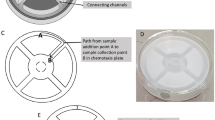Abstract
Azospirillum brasilense was attracted to capillaries containing either phosphate buffer, distilled water, or saline. The number of bacteria in these capillaries was 3−4×104, after 1 h of incubation. In the presence of phosphate buffer + attractants, the number of cells accumulated in the capillary increased only to 5×104–1.1×105 cells. It was not possible, therefore, to measure chemotaxis inA. brasilense as distinct from aerotaxis by the capillary method. Chemotaxis was observed in semi-solid agar plates and was determined by a growth band oriented towards the attractant. Positive chemotactic response was obtained with peptone, tryptone, yeast extract, amino acids, organic acids, arabinose and galactose.
Similar content being viewed by others
References
Adler, J.: Chemotaxis in bacteria. Science153, 708–716 (1966)
Adler, J.: A method for measuring chemotaxis and use of the method to determine optimum conditions for chemotaxis byEscherichia coli. J. Gen. Microbiol.74, 77–91 (1973)
Caraway, B. H., and N. R. Krieg: Aerotaxis ofSpirillum volutans. Can. J. Microbiol.20, 1367–1377 (1974)
Chet, I., Y. Zilberstein, and Y. Henis: Chemotaxis ofPseudomonas lachrymans to plant extracts and to water droplets collected from the leaf surfaces of resistant and susceptible plants. Physiol. Plant Pathol.3, 473–479 (1973)
Currier, W. W., and G. A. Strobel: Chemotaxis ofRhizobium spp. to plant root exudates. Plant Physiol.57, 820–823 (1976)
Neyra, C. A., and J. Dobereiner: Nitrogen fixation in grasses. Adv. Agron.29, 1–38 (1977)
Okon, Y., S. L. Albrecht, and R. H. Burris: Factors affecting growth and nitrogen fixation ofSpirillum lipoferum. J. Bacteriol.127, 1248–1254 (1976)
Okon, Y., S. L. Albrecht, and R. H. Burris: Methods for growingSpirillum lipoferum and for counting it in pure culture and in association with plants. Appl. Environ. Microbiol.33, 85–88 (1976)
Okon, Y., J. P. Houchins, S. L. Albrecht, and R. H. Burris: The growth ofSpirillum lipoferum at constant partial pressures of oxygen and the properties of its nitrogenase in cell free extracts. J. Gen. Microbiol.98, 87–93 (1977)
Rovira, A. D.: Plant root exudates. Bot. Rev.35, 35–57 (1969)
Tarrand, J. J., N. R. Krieg, and J. Dobereiner: A taxonomic study of theSpirillum lipoferum group, with descriptions of a new genus,Azospirillum lipoferum (Bijerinck) comb. nov. andAzospirillum brasilense sp. nov. Can. J. Microbiol.24, 967–980 (1978)
Author information
Authors and Affiliations
Rights and permissions
About this article
Cite this article
Okon, Y., Cakmakci, L., Nur, I. et al. Aerotaxis and chemotaxis ofAzospirillum brasilense: A note. Microb Ecol 6, 277–280 (1980). https://doi.org/10.1007/BF02010393
Issue Date:
DOI: https://doi.org/10.1007/BF02010393




